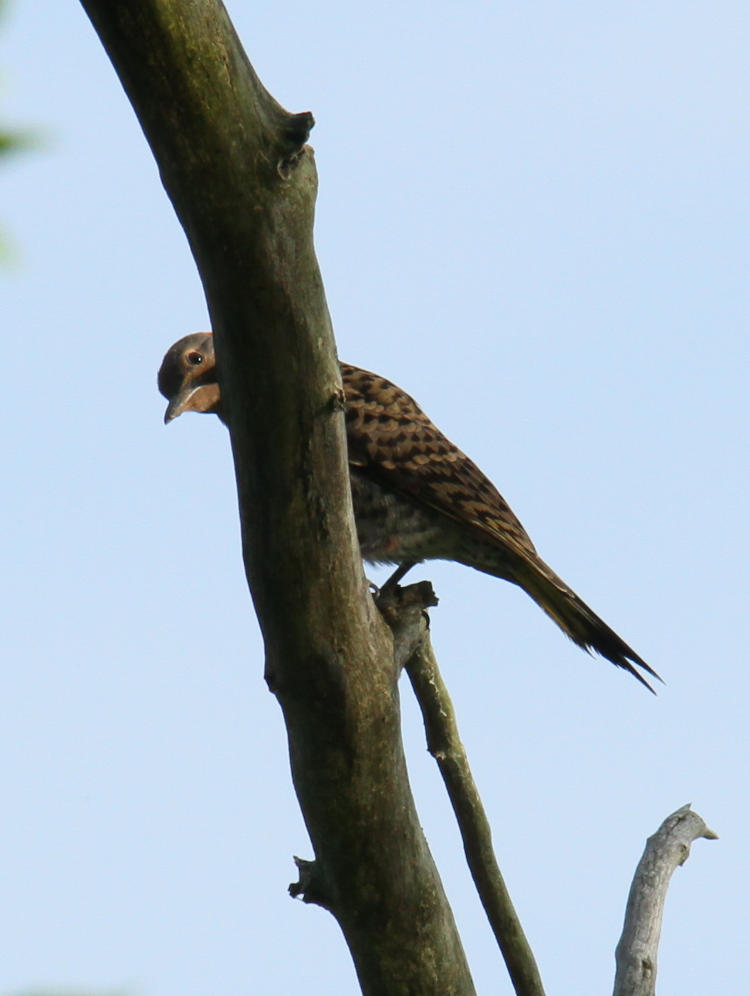
I’ve already done posts on the birds seen during the New York trips, both the raptors and the non-raptors, but didn’t go through the photos thoroughly enough, because there were several more that I intended to feature, so we’re now getting to that (with a couple of other subjects thrown in as a bonus to you, the 10th visitor to this blog.) Above, one of a quartet of northern flickers (Colaptes auratus,) which I’m fairly certain were new fledglings, peeks out at me during an extended but mostly hidden foraging session at the Gatsby mansion, taking place over more than an hour – much of the time, I was concentrating on the ospreys nearby, even when I could hear their distinctive calls as they flipped between the trees. The black cheek stripe (malar) pegs this as an eastern, or yellow-shafted, variant, distinctively colored yet apparently not a subspecies.
On one of the visits to Montezuma National Wildlife Refuge, both The Girlfriend and I heard the sharp call of a green heron (Butorides virescens,) but she was the one that spotted it, peeking out from the top of a tree alongside the channel.

The distance was significant and the car was motionless, so I doubted that it was reacting to us, but it soon flew off without any other apparent provocation, so it was either us, or it spotted something else that it felt merited attention, perhaps an interloper out of our sight beyond the marsh grasses. But I snagged a nice action pose out of it.
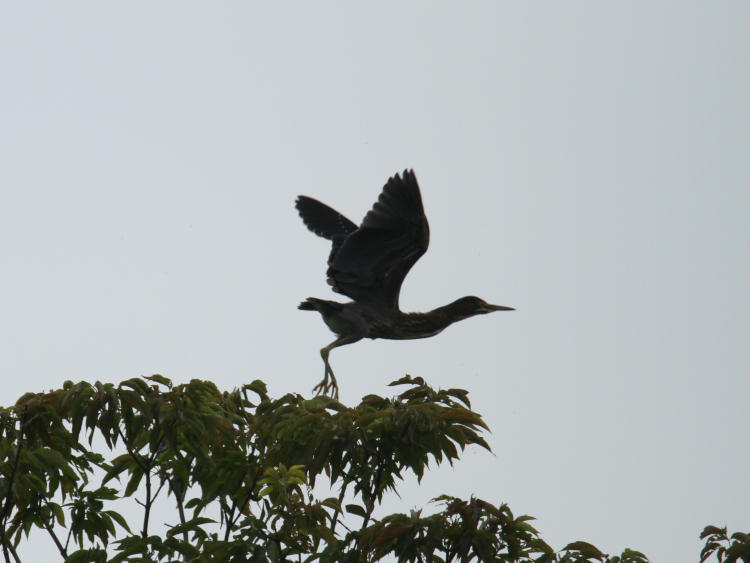
For some reason, I’m having a devil of a time getting decent photos of a belted kingfisher (Megaceryle alcyon.) I mean, I know they don’t like close approaches and fly off whenever I seem to get within 30 meters, but they’re fairly common birds around the ponds and streams, all throughout the US – I just can’t seem to get a solid shot of one. On another visit to the refuge, I spotted two perched in the open, and within a refuge you’d expect the birds to be more conditioned to people, allowing better opportunities, right? It certainly held true for many species that I saw, and it might have been true for the kingfishers too, except that their perches were far enough off to prevent that nice tight shot that I was after, and both were towards the early morning sun, so backlit. Sheesh.

The first was a female, and was at least facing me but, you know, sun and distance. And the choice of a perching spot was less than photogenic. At least it turned enough to get a little light on its eye, so, yay?
The male, a few hundred meters further on, was no better.

This one found another sign to perch on, because why use nice scenic snags or anything? With his back turned, you don’t even have a good view of the orange breast, though there’s a peek here. There was no chance of circling around or trying for a better vantage, even if I flouted the proscriptions against leaving your car in these areas, because they were many meters off across a thicket of marsh grasses and swampland, treacherous and above all noisy to navigate. But I still don’t understand how I’ve gone so many years and never gotten a frame of this species that I’m really happy with.
I previously mentioned following one of the walking trails, which didn’t produce a lot of interest, but I snagged a handful of frames nonetheless.

Land snails of any kind were almost nonexistent while I lived up there, much less sizable, colorful specimens, so it was curious to spot several back in 2015, and I found the same species on this trip. It goes by countless names, though the most common seems to be the brown-lipped snail, but better to stick with Cepaea nemoralis. It’s an invasive, European species, and what I found both times fit within the typical size, which is roughly 25mm across. The others were in the frame just for the sake of it, and remain unidentified.
I also came across a curious tableau right at my feet, which I misinterpreted until looking at the photos later on – otherwise I might have done more examination, at least.
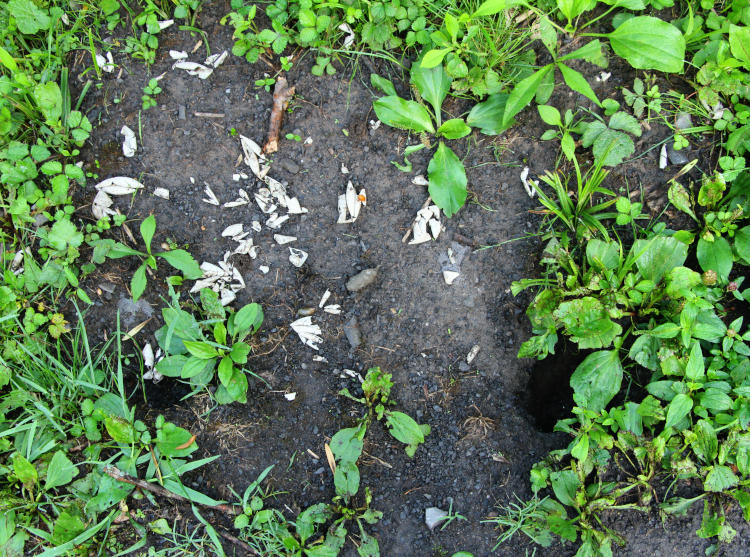
I initially though this was a collection of dried, bleached crayfish fragments outside the burrow of whatever ate them, but looking at the photos I realized that these were instead turtle shells, evidence of a nest that had been there. Since I’d seen a painted turtle laying eggs the last time I’d been up only a few weeks previously, this was in the right time frame. However, another detail caught my eye, so we’ll go in for a closer look (even though my photos aren’t the best.)
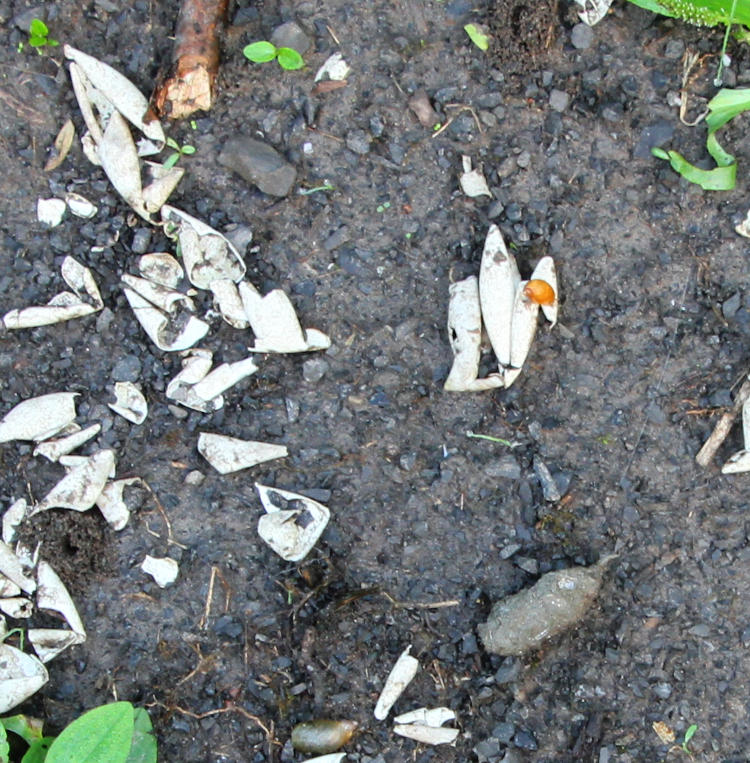
The larger, grey item at lower right is the key bit, since the size, shape, and texture lead me to believe this is either a fecal deposit, or a casting (a pellet of undigestable hair and bones coughed up by raptors some time after a meal.) The hairlike texture, especially that tapered end, sure look suspiciously like either. So now I’m not sure that I didn’t discover evidence of a raided nest, since I would think that the eggshells would remain buried and hidden if the young turtles hatched out normally. Raptors typically do not dig for food, so I’m leaning towards raccoon or opossum.
While we’re on the subject of mammals…
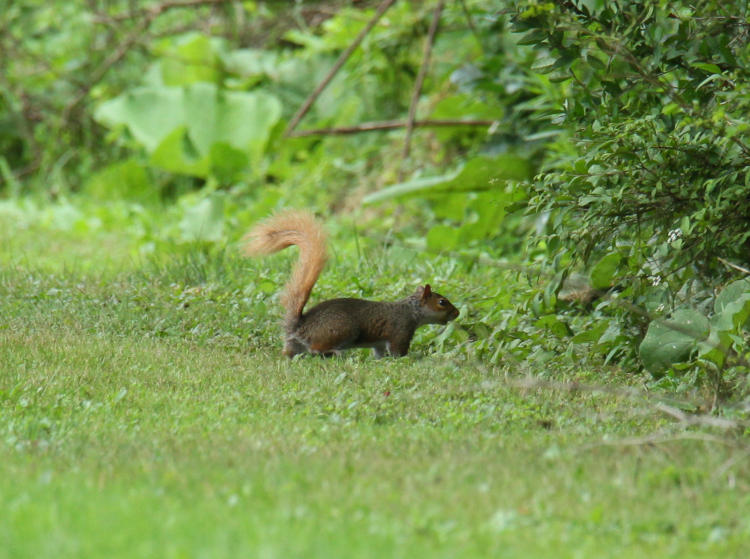
… The Girlfriend pointed out this eastern grey squirrel (Sciurus carolinensis) while we were at the Gatsby Mansion, since it sported this brilliant red-blonde tail, well outside of any color variation that I’ve ever seen them in. It did not appear diseased or otherwise different, just a dye job only on the tail itself. The best view we had of it was, naturally, when the camera was not in hand, and by the time I got it ready, the squirrel had scurried much farther off, so this is what I got. We never saw it again, despite keeping a careful eye out.
Okay, back to the refuge.
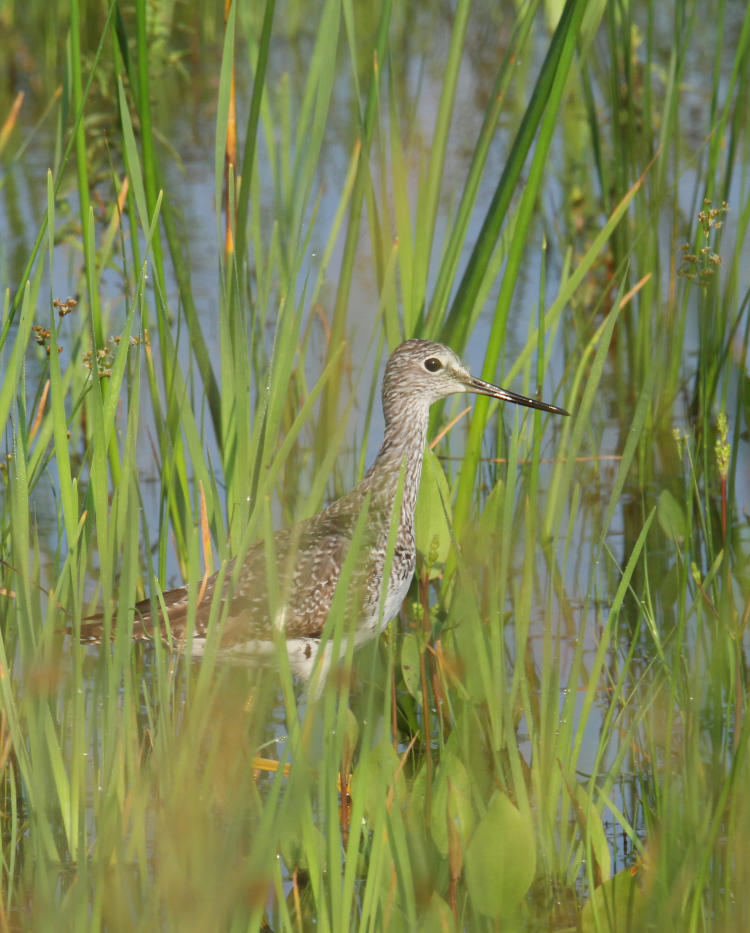
I featured a teaser image for the end-of-the-month abstracts, and finally got around to posting the better photos. I was a little surprised to find a willet (Tringa semipalmata) foraging along the edges of a marsh pond in the refuge, thinking they were shorebirds and perhaps southern at that, but it appears that their range is well into the central New York region, so phooey on me. This one was fairly close but always partially obscured by reeds, so much so that even snagging sharp focus was tricky.
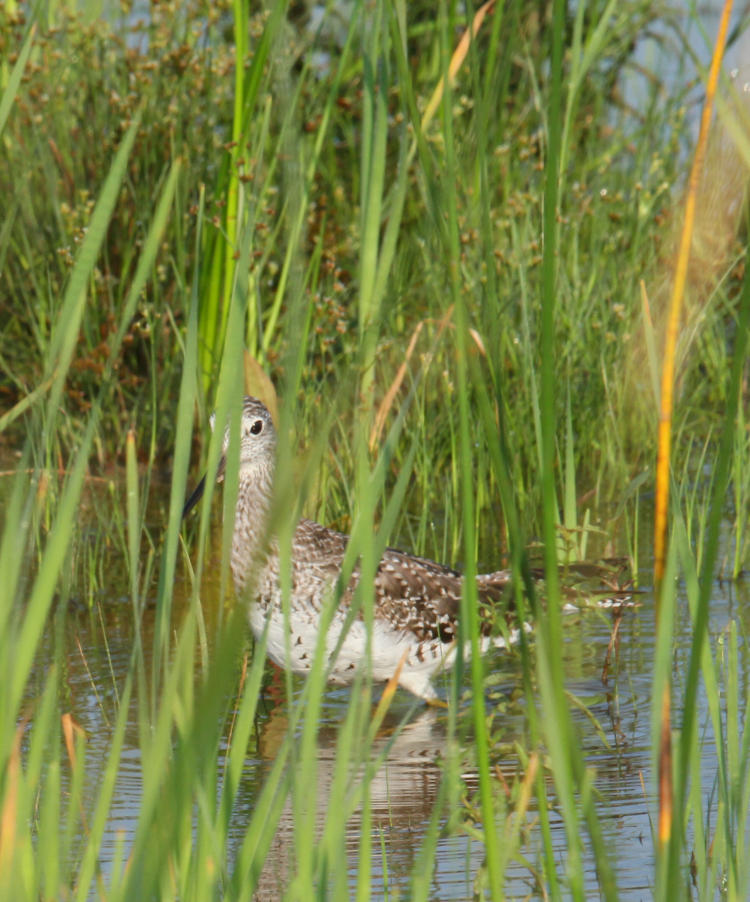
I’m not sure who was spying on whom here, to be honest; we’ll call it a draw. Unlike the kingfishers on the exact same day, the light and the shooting distance was in my favor at least.
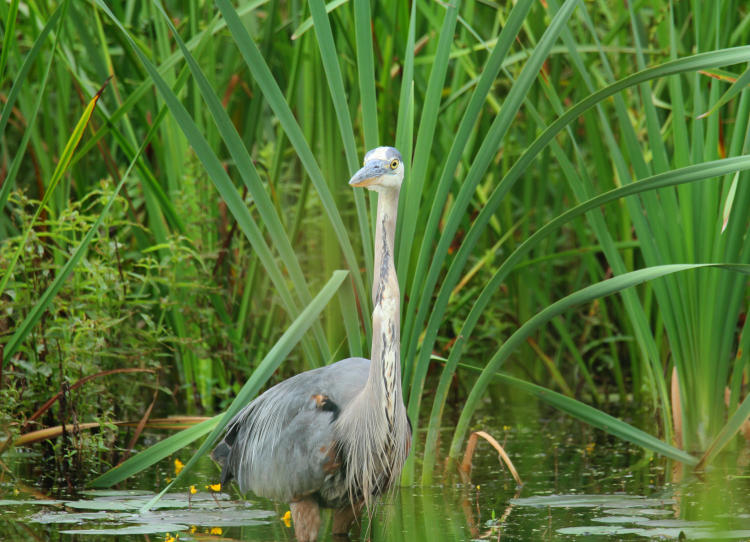
Just a great blue heron (Ardea herodias) using the spray of reeds behind it to try and show off, obviously a case of peacock envy, according to Freud.
And finally, a couple of still photos from the same time that I was capturing video.

This was better than 330 meters off (I measured it with the map afterward,) so cropped significantly because even 600mm can’t handle that distance easily. It’s a bald eagle of course (Haliaeetus leucocephalus) fending off the attacks of a pair of northern harriers (Circus hudsonius.) The eagle was trying to mind its own business, but the nest of the harriers must have been close by, because they wanted the eagle gone; I watched their attacks for several minutes.

A little wider here to show the pair in the air, alternating on their strafing runs even after the eagle hopped down to the lower limb; I never saw either make contact, though there was at least one close call when the eagle was too slow in raising its beak in warning. While there, with the much smaller view through the camera, I thought I saw the telltale white rump, and examining the photos afterward confirmed my identification. You can see the white rump of the male over to the right, at the base of the tail, while other frames of the female (not as dynamic as these,) show her largely white underbody and underwing coloration with the dark trailing edges.
The building in the background, by the way, is the Refuge visitor center, recognizable by the purple martin houses alongside, those large white boxes on poles – it is nearly three kilometers off, on the opposite side of this part of the refuge. All of that in between is marsh and bog, the soggy region off the northern tip of Cayuga Lake. These particular photos were taken from an observation platform next to the interstate, right alongside the excellent eagle sculpture by James Seaman, that we discovered was damaged by high winds not long after we’d visited and is presently in for repairs.

Anyway, now we should be done with the NY photos. Probably. I think…




















































